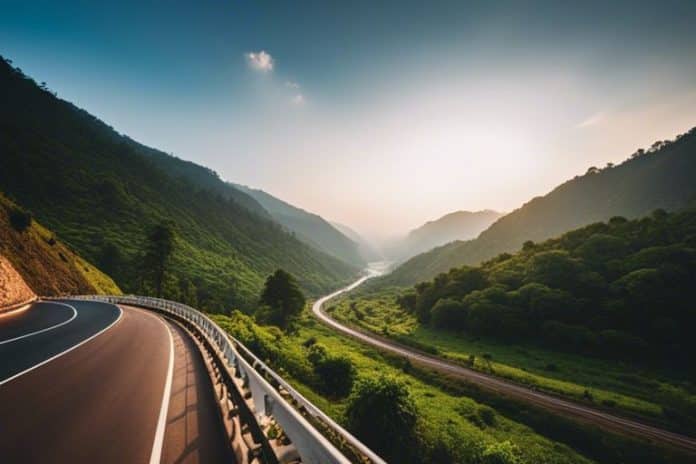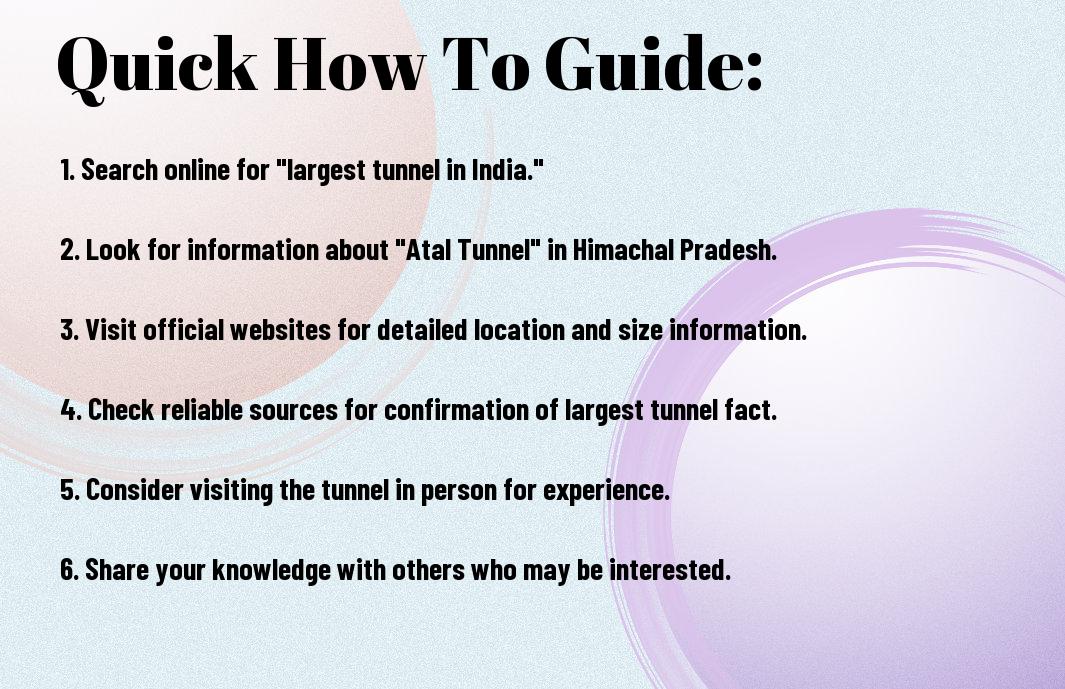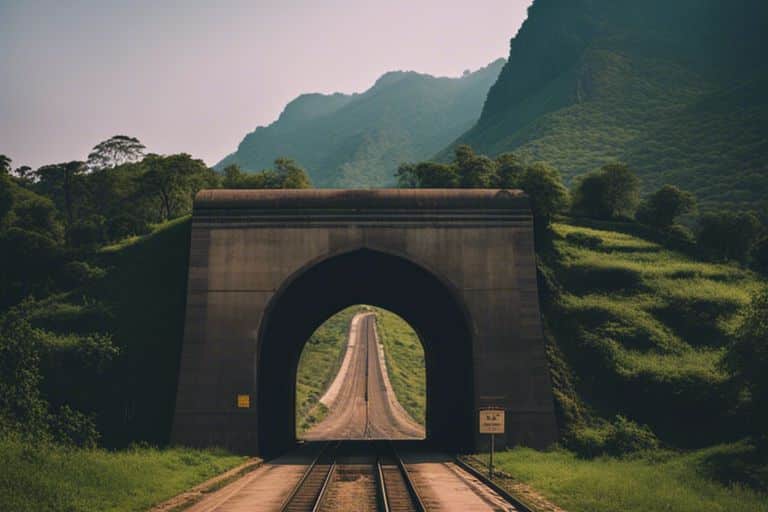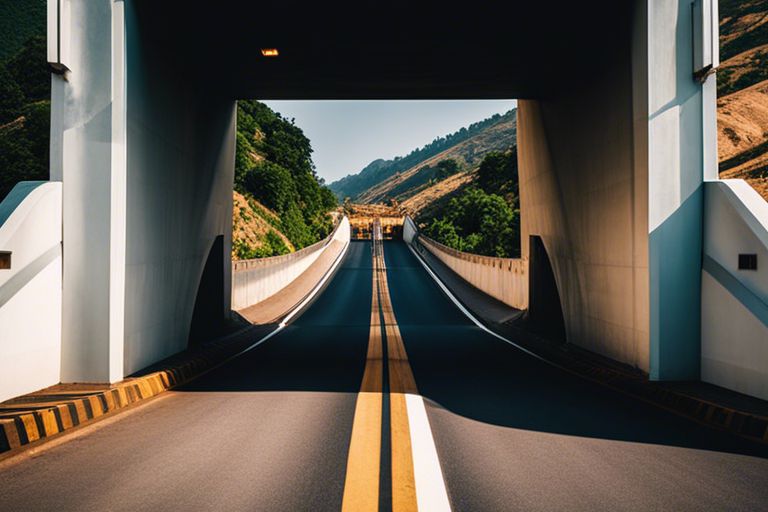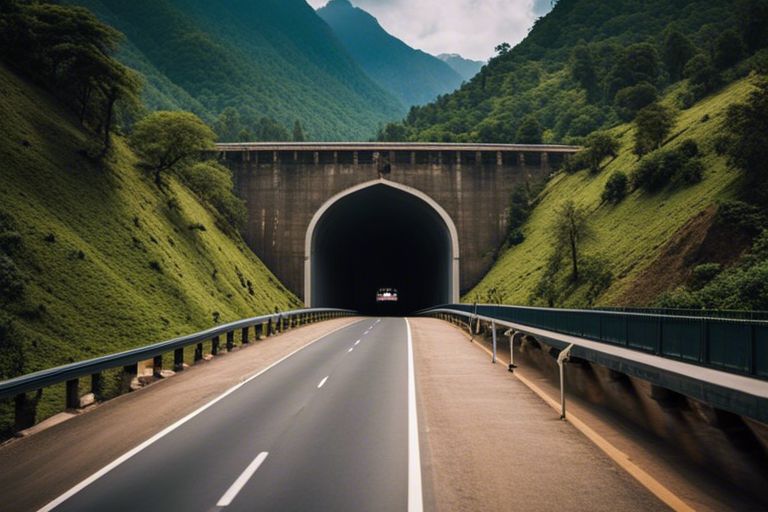Largest in size and a marvel of engineering, the Pir Panjal Railway Tunnel holds the title of being the largest tunnel in India. This remarkable infrastructure project is located in the northern state of Jammu and Kashmir, cutting through the formidable Pir Panjal range of the Himalayas.
Stretching over 11.215 kilometers, this tunnel significantly reduces travel time and provides an all-weather connection between the regions of Banihal and Qazigund. It is a critical link for the Indian Railways, enhancing transportation efficiency and connectivity in the region. However, the construction of this tunnel posed numerous challenges due to the rugged terrain and harsh weather conditions in the area.
The Pir Panjal Railway Tunnel stands as a testament to human ingenuity and perseverance, showcasing India’s capabilities in undertaking complex infrastructure projects. Its strategic location and immense benefits make it a vital part of the country’s transportation network, facilitating smoother movement of goods and people across this challenging terrain.
Key Takeaways:
- Roji Roti Tunnel: The Roji Roti Tunnel in Jammu & Kashmir is the longest tunnel in India.
- Location: The Roji Roti Tunnel is located in the Pir Panjal range of Jammu & Kashmir.
- Length: The tunnel is approximately 8.45 kilometers long, making it the largest in India.
- Construction: The Roji Roti Tunnel was constructed to improve connectivity in the region and reduce travel time.
- Importance: The tunnel plays a crucial role in enhancing transportation and connectivity in Jammu & Kashmir.
- Features: The Roji Roti Tunnel has advanced ventilation and safety systems to ensure smooth traffic flow.
- Significance: The tunnel facilitates all-weather connectivity between Jammu and Srinagar, benefiting the local population and tourists alike.
The Largest Tunnel in India
Overview of the Record-Breaking Structure
India is home to the longest railway tunnel in the country, Pir Panjal Railway Tunnel, also known as Banihal Railway Tunnel. This engineering marvel stretches over 11.2 kilometers, making it the longest transportation tunnel in India. Completed in 2013, the tunnel provides a vital link between the Kashmir Valley and Jammu regions, significantly reducing travel time and improving connectivity.
The Pir Panjal Railway Tunnel runs beneath the Pir Panjal mountain range in the Himalayas, at an elevation of approximately 2,800 meters above sea level. The tunnel’s construction involved intricate planning and cutting-edge technology to overcome challenges posed by the mountainous terrain and harsh weather conditions in the region. The tunnel is a testament to India’s engineering prowess and plays a crucial role in enhancing transportation infrastructure in the region.
With its strategic location and impressive length, the Pir Panjal Railway Tunnel stands as a symbol of India’s commitment to infrastructural development and connectivity. The tunnel not only facilitates smoother rail transport but also showcases the nation’s ability to undertake and execute large-scale projects successfully.
Historical Significance and Construction Insights
Record-breaking in its own right, the Pir Panjal Railway Tunnel holds historical significance as a pivotal infrastructure project in India. The tunnel’s construction spanned over six years and involved cutting through solid rock to create a passageway for trains. The challenges included maintaining ventilation, providing emergency exits, and ensuring the safety of workers during the construction process.
Insights: The construction of the Pir Panjal Railway Tunnel required extensive planning and engineering expertise to overcome the geological hurdles posed by the Himalayan terrain. The tunnel’s completion has not only facilitated smoother rail travel but has also opened up new opportunities for economic growth and development in the region. The tunnel stands as a shining example of India’s determination to conquer geographical barriers and enhance connectivity for its citizens.
How to Identify Major Tunnels in India
Criteria for Measuring Tunnels
Keep in mind that when identifying major tunnels in India, you need to consider certain criteria. Tunnels are measured based on their length, with longer tunnels usually being classified as major tunnels. Additionally, the depth and width of the tunnel are important factors to take into account. The purpose of the tunnel, whether it is for transportation, irrigation, or any other use, also plays a significant role in identifying major tunnels.
Key Features of Large-Scale Tunnels
When looking at large-scale tunnels in India, there are several key features that set them apart from smaller tunnels. Key Features typically include advanced ventilation systems, lighting, and safety features to ensure the well-being of those using the tunnel. Additionally, the construction materials used in large-scale tunnels are of higher quality and durability to withstand the test of time.
- Length: Major tunnels are typically longer in length, spanning several kilometers
- Width: Large-scale tunnels have a wider diameter to accommodate different types of vehicles
- Usage: Major tunnels serve a crucial purpose, whether it’s for transportation, water supply, or other needs
Identifying major tunnels in India can be a daunting task, but by focusing on these key features, you can easily distinguish them from smaller tunnels. This will help in understanding the significance and impact of major tunnels on infrastructure development in the country.
Features
One of the most important aspects to consider when identifying major tunnels is their length. Longer tunnels often indicate a more extensive project that serves a critical purpose. Additionally, dangerous conditions such as poor ventilation or inadequate lighting are red flags that the tunnel may not meet safety standards. On the other hand, positive features like state-of-the-art ventilation systems and emergency exits demonstrate a commitment to ensuring the safety and well-being of tunnel users.
Geographic Location of India’s Largest Tunnel
Despite being known for its diverse landscapes and challenging terrains, India is also home to one of the most remarkable engineering feats – the country’s largest tunnel. Located in the northern region of India, this tunnel stands as a testament to human ingenuity and perseverance in conquering nature’s obstacles.
Region-Specific Characteristics
Clearly, the geographic location of India’s largest tunnel plays a significant role in its construction and functionality. Nestled amidst the majestic mountains of the Himalayas, this tunnel is a marvel of modern engineering in a region known for its rugged terrain and harsh weather conditions. The tunnel’s location presents unique challenges, requiring innovative solutions to ensure its construction and operation despite the adverse environmental factors.
Connectivity and Strategic Advantages
Region-Specific characteristics aside, the connectivity provided by India’s largest tunnel is a game-changer in enhancing transportation links between different regions. Serving as a vital passage for both civilian and military traffic, the tunnel’s strategic advantages cannot be overstated. The tunnel not only reduces travel time but also provides a crucial link for remote areas, unlocking economic opportunities and improving access to important services.
Plus, the tunnel’s strategic location offers a crucial advantage for defense and security purposes. Its presence enhances border surveillance and facilitates rapid troop movements, strengthening the country’s preparedness and response capabilities. The tunnel stands as a symbol of India’s commitment to progress and development, showcasing the nation’s ability to overcome geographical challenges through innovation and determination.
How to Analyze the Engineering Marvels of Tunnels
All
Factors to Consider in Tunnel Engineering
When analyzing the engineering marvels of tunnels, there are several factors to consider that contribute to their successful construction. These factors play a crucial role in ensuring the safety, durability, and efficiency of tunnels.
- Geological Condition: Understanding the geological conditions of the site where the tunnel will be constructed is crucial. Factors such as rock type, fault lines, and water ingress can greatly impact the design and construction process.
- Topography: The topography of the area plays a significant role in determining the alignment, depth, and length of the tunnel. Engineers must carefully study the terrain to design a tunnel that minimizes the impact on the environment and surrounding infrastructure.
- Structural Design: The structural design of the tunnel must take into account factors such as the expected traffic load, ventilation requirements, and emergency exits. A well-designed tunnel ensures the safety and comfort of users.
Perceiving the importance of these factors is crucial in evaluating the success of a tunnel project and ensuring its long-term functionality.
Advanced Technologies in Modern Tunnel Construction
Any
Advanced Technologies in Modern Tunnel Construction
| Technology | Benefits |
| Bored Tunneling Machines | Speeds up excavation process and minimizes disruption to the surrounding environment. |
| High-Strength Reinforcement Materials | Increases the durability and longevity of the tunnel structure. |
- Monitoring Systems: Advanced monitoring systems allow engineers to track the performance of the tunnel in real-time, ensuring early detection of any issues.
- Automated Construction Equipment: Automation technology helps improve construction efficiency and accuracy, reducing human error and labor costs.
A comprehensive understanding of these advanced technologies is crucial for successfully constructing modern tunnels that meet the highest standards of safety and functionality.
How to Understand Tunnel Architecture
Design Elements of Tunnel Architecture
Architecture in tunnel design goes beyond the mere construction of a passage through a mountain or under a water body. It involves a meticulous consideration of various design elements that contribute to the functionality and aesthetics of the tunnel. These design elements include the shape and gradient of the tunnel, the materials used for construction, ventilation systems, lighting arrangements, and emergency evacuation provisions.
Understanding the design elements of tunnel architecture is crucial for ensuring the safety and efficiency of the tunnel. The shape and gradient of the tunnel determine its stability and ease of passage for vehicles or trains. The materials used play a significant role in withstanding pressure, preventing collapses, and ensuring the durability of the tunnel. Ventilation systems are imperative for maintaining air quality and regulating temperature within the tunnel.
Lighting arrangements not only serve a functional purpose by providing visibility for drivers but also contribute to the aesthetic appeal of the tunnel. Emergency evacuation provisions, such as escape routes and emergency stations, are critical for ensuring the safety of passengers in case of unforeseen events.
The Integration of Safety and Aesthetic in Tunnel Design
One of the fundamental principles in tunnel architecture is the integration of safety and aesthetic considerations in design. While the primary function of a tunnel is to provide a passageway, it should also be visually appealing and harmonious with its surroundings. This integration ensures that the tunnel not only serves its functional purpose but also enhances the overall infrastructure and landscape.
Understanding the integration of safety and aesthetic in tunnel design requires a delicate balance between structural robustness and visual aesthetics. Safety features such as emergency exits, fire suppression systems, and drainage mechanisms should be seamlessly incorporated into the design without compromising the visual appeal of the tunnel. Aesthetically pleasing elements such as architectural lighting, artistic wall treatments, and landscaping around the tunnel entrance can enhance the overall experience for users.
This integration reflects a holistic approach to tunnel architecture, where safety considerations are prioritized without neglecting the importance of visual appeal. A well-designed tunnel not only ensures the smooth flow of traffic but also enriches the environment through its thoughtfully crafted design elements.
Exploring the Environmental Impact of Building Tunnels
Environmental Planning for Tunnel Projects
After the decision is made to construct a tunnel, environmental planning becomes a crucial step in the project. Some key considerations include conducting thorough environmental impact assessments to understand the potential effects on the surrounding ecosystem. This involves studying the soil composition, water table levels, wildlife habitats, and air quality in the area. By identifying any sensitive environmental areas, planners can incorporate measures to minimize disruption during construction.
Environmental planning also involves engaging with local communities and stakeholders to gather their input and address any concerns they may have regarding the tunnel project. It is crucial to ensure that the construction process takes into account the cultural and social aspects of the region, in addition to the environmental impact. By fostering open communication and collaboration, project leaders can work towards a more sustainable and harmonious integration of the tunnel into the surrounding environment.
Furthermore, environmental planning for tunnel projects includes developing comprehensive mitigation and monitoring plans to track the project’s impact throughout the construction phase and beyond. These plans aim to mitigate negative effects on the environment by implementing measures such as erosion control, waste management, and habitat restoration. By incorporating these strategies into the project design early on, planners can proactively address potential environmental concerns and ensure the long-term sustainability of the tunnel.
Mitigation Strategies in Tunnel Construction
Mitigation strategies play a critical role in minimizing the environmental impact of tunnel construction. Some common strategies include implementing advanced technology to reduce noise pollution and air emissions during excavation and tunneling activities. Additionally, utilizing innovative construction techniques such as tunnel boring machines can help minimize surface disruption and habitat fragmentation. These strategies not only enhance the efficiency of construction but also significantly reduce the project’s environmental footprint.
Mitigation efforts also focus on preserving water quality and managing stormwater runoff from construction sites. By implementing sediment control measures and erosion prevention techniques, project teams can prevent soil erosion and protect nearby water bodies from contamination. Moreover, reusing excavated materials for landscaping or backfilling can reduce the need for additional resources and minimize the environmental impact of transporting materials to and from the construction site.
Mitigation strategies in tunnel construction are continuously evolving as technologies and best practices advance. By staying updated on the latest innovations and industry trends, project teams can continually improve their environmental performance and strive towards sustainable construction practices. Through a proactive approach to mitigation, tunnel projects can not only minimize their environmental impact but also contribute to the preservation and enhancement of the surrounding ecosystem.
Impact
Overall, the environmental impact of tunnel construction can be significant, with the potential to disrupt ecosystems, alter landscapes, and affect local communities. However, by implementing comprehensive environmental planning, engaging with stakeholders, and employing effective mitigation strategies, the negative effects can be minimized. The construction of tunnels can also bring about positive impacts, such as improved transportation infrastructure, reduced traffic congestion, and enhanced connectivity between regions. By balancing these factors and prioritizing sustainability in project planning and execution, tunnels can be developed in a way that benefits both society and the environment.
How to Appreciate the Economic Benefits of Large Tunnels
Cost-Benefit Analysis of Tunnel Projects
Benefits: When considering the economic benefits of large tunnels, a cost-benefit analysis is crucial. This analysis helps in determining if the advantages of constructing a tunnel outweigh the costs associated with it. Large tunnels can significantly reduce travel time, enhance connectivity between regions, and stimulate economic growth by facilitating the transportation of goods and people.
Despite the initial high costs of tunnel construction, the long-term benefits are immense. Reduced transportation times lead to savings in fuel consumption, vehicle maintenance, and overall travel expenses. Additionally, large tunnels can attract investments to the surrounding areas, promoting local businesses and boosting employment opportunities.
Moreover, large tunnels often result in improved safety for travelers by bypassing accident-prone areas and minimizing the risks associated with natural disasters. This increased safety not only saves lives but also reduces the economic burden of accidents on society.
The Socio-Economic Influence of Tunnels on Development
To understand the socio-economic influence of tunnels on development, one must consider the ripple effect they have on communities. Large tunnels can transform remote areas into bustling hubs of activity by providing easier access to markets, healthcare, and education. This accessibility fosters social integration and encourages investment in infrastructure and services.
Large tunnels serve as lifelines for regions cut off from mainstream development and can bridge the gap between urban and rural areas. This connectivity not only enhances the quality of life for residents but also opens up new opportunities for businesses to expand and thrive. Additionally, improved transportation networks attract tourism, further stimulating economic growth in the region.
Tips for Safely Navigating Through Large Tunnels
Your safety is paramount when navigating through large tunnels. Here are some tips to ensure a safe journey:
- Avoid distractions while driving through the tunnel.
- Maintain a safe distance from the vehicle in front of you.
- Turn on your headlights to improve visibility.
- Follow all traffic signs and speed limits.
- Stay in your lane and avoid unnecessary lane changes.
Assume that emergency services may take longer to reach you inside a tunnel, so it’s crucial to drive cautiously and be prepared for any situation. For more information on tunnel safety, you can visit Atal Tunnel.
Understanding Tunnel Safety Features
Clearly, tunnels are equipped with various safety features to ensure the well-being of commuters. These include:
- Emergency exit points at regular intervals.
- Proper ventilation systems to minimize the risk of air pollution.
- Fire detection and suppression systems for quick responses to emergencies.
Moreover, tunnels are constructed with robust materials to withstand natural calamities and accidents, providing a secure passage for commuters and vehicles.
Best Practices for Commuters and Transport Operators
Safety is the top priority for both commuters and transport operators when traversing through tunnels. Some best practices to follow include:
- Regular maintenance checks on vehicles to prevent breakdowns inside tunnels.
- Keeping a first aid kit and emergency supplies handy in case of unforeseen events.
- Training drivers and staff on tunnel safety protocols and emergency procedures.
Transport operators play a crucial role in ensuring the safe passage of commuters through large tunnels. By adhering to best practices and staying vigilant, the risk of accidents can be significantly reduced, providing a smooth and secure journey for all.
Preservation and Maintenance of Tunnels
The Role of Maintenance in Tunnel Longevity
Now, let’s explore into the critical aspect of the preservation and maintenance of tunnels. Maintenance plays a pivotal role in ensuring the longevity and structural integrity of tunnels. Regular inspections, repairs, and upgrades are imperative to prevent deterioration and ensure the safety of tunnel users. Proper maintenance practices help extend the lifespan of tunnels, reducing the risks of accidents and costly repairs.
While routine maintenance may seem like a mundane task, it is fundamental to the efficient operation of tunnels. Regular inspections help identify potential issues such as cracks, water leaks, or material degradation. Addressing these issues promptly through repair and reinforcement work can prevent further damage and preserve the structural stability of the tunnel. Upgrading obsolete systems and technological components also enhance the safety and functionality of tunnels.
Effective maintenance strategies involve a combination of preventive and corrective measures to ensure the longevity of tunnels. By investing in regular maintenance activities, tunnel operators can minimize risks and optimize the performance of these vital infrastructural assets.
Innovations and Challenges in Tunnel Preservation
While maintenance is crucial, innovations and challenges in tunnel preservation also shape the future of tunnel infrastructure. Challenges such as geological shifts, environmental factors, and increasing traffic volumes pose significant hurdles to preserving tunnels. Innovations in materials technology and construction techniques offer promising solutions to enhance the durability and resilience of tunnels.
It is imperative to stay abreast of the latest technological advancements in tunnel preservation to address emerging challenges effectively. Developing sustainable practices and incorporating smart technologies can improve the resilience of tunnels against natural disasters and wear and tear. Collaboration between industry experts and researchers is also vital to drive innovation and overcome preservation challenges.
It is imperative that tunnel operators and relevant authorities prioritize preservation efforts and adopt a proactive approach to tackle evolving challenges. By embracing innovations and best practices in tunnel maintenance, we can ensure the sustainability and safety of tunnels for generations to come.
Future Prospects and Expansions
Upcoming Tunnel Projects in India
Once again, India is set to initiate on some ambitious tunnel projects that will further solidify its position in infrastructure development. Any upcoming tunnel projects in India are expected to focus on improving connectivity in remote regions, enhancing transportation networks, and reducing travel times between key locations.
Any major tunnel projects to look out for include the Char Dham project in Uttarakhand, Rohtang Tunnel in Himachal Pradesh, and Zoji La Tunnel in Jammu and Kashmir. These projects aim to overcome geographical barriers, provide all-weather connectivity, and promote tourism in the region.
With advancements in technology and engineering capabilities, upcoming tunnel projects in India are not just about creating passageways but also about showcasing the country’s prowess in infrastructure development on a global scale. The future of tunnel construction in India looks promising with a focus on sustainability, safety, and innovation.
Predictions for Future Tunneling Technologies and Methods
The future of tunneling technologies and methods in India holds great promise with the integration of automation, artificial intelligence, and robotics in construction processes. Advanced monitoring systems, predictive maintenance techniques, and real-time data analytics are expected to revolutionize tunneling operations.
The adoption of tunnel boring machines (TBMs) for faster and more efficient excavation, along with the use of sustainable materials and construction practices, will define the future of tunneling in India. The emphasis on minimizing environmental impact, ensuring structural integrity, and enhancing passenger safety will drive innovation in the sector.
Tunnel engineers and construction companies are poised to leverage cutting-edge technologies such as 3D printing, alternative energy sources, and smart infrastructure solutions to overcome challenges and set new benchmarks in tunnel construction. The future of tunneling in India is not only about building bigger and longer tunnels but also about setting new standards for efficiency, reliability, and sustainability.
To wrap up
Taking this into account, it is clear that the longest tunnel in India is the Atal Tunnel, also known as the Rohtang Tunnel. This engineering marvel is located in the state of Himachal Pradesh and holds great strategic and touristic significance. As one of the 10 longest tunnels in India, the Atal Tunnel offers an impressive infrastructure that connects Manali to Lahaul-Spiti valley, making travel smoother and more efficient in the region. To explore more about the longest tunnels in India, you can refer to 10 Longest Tunnels in India You Would Love to Drive … for detailed insights.
With advancements in technology and infrastructure, tunnels like the Atal Tunnel demonstrate India’s capability in creating modern transportation networks to enhance connectivity across different regions. The construction of such tunnels not only facilitates travel but also boosts economic activities, tourism, and overall development. As we look towards the future, similar projects aimed at improving connectivity and accessibility are likely to be undertaken, furthering India’s infrastructural growth.
When all is said and done, the Atal Tunnel stands out as the largest tunnel in India, showcasing the nation’s engineering prowess and commitment to enhancing connectivity. As travelers seek efficient routes through challenging terrains, tunnels like these play a crucial role in making transportation smoother and faster. The development of such infrastructure underscores India’s progress and ambition to create modern transport networks that benefit various sectors of society.
FAQ
Q: Which Is The Largest Tunnel In India And Where Is It Located?
A: The Atal Tunnel, also known as Rohtang Tunnel, is the longest tunnel in India. It is located in the northern state of Himachal Pradesh.
Q: What is the length of the Atal Tunnel?
A: The Atal Tunnel spans a length of approximately 9.02 kilometers, making it the longest tunnel in India.
Q: When was the Atal Tunnel opened for public use?
A: The Atal Tunnel was inaugurated on October 3, 2020, by Prime Minister Narendra Modi and opened for public use on the same day.
Q: What is the significance of the Atal Tunnel?
A: The Atal Tunnel holds immense strategic importance as it provides all-weather connectivity to the remote regions of Himachal Pradesh, especially the Lahaul-Spiti Valley.
Q: How was the Atal Tunnel constructed?
A: The Atal Tunnel was constructed using the New Austrian Tunnelling Method (NATM) under the Pir Panjal range of the Himalayas at an altitude of over 10,000 feet.
Q: What are the key features of the Atal Tunnel?
A: The Atal Tunnel is a single-tube, double-laned tunnel that reduces the distance between Manali and Keylong by around 46 kilometers. It also has an emergency tunnel built into it for safety purposes.
Q: Is the Atal Tunnel open to all vehicles?
A: Yes, the Atal Tunnel is open to all kinds of vehicles, including cars, buses, and motorcycles. However, the tunnel has restrictions on the movement of hazardous goods vehicles.
